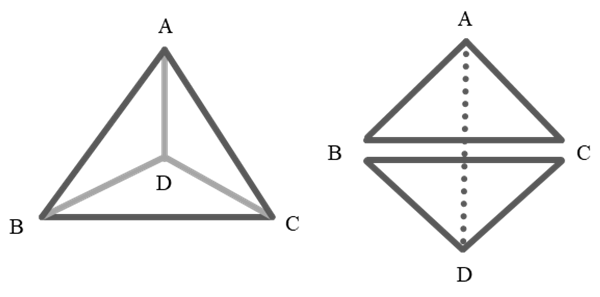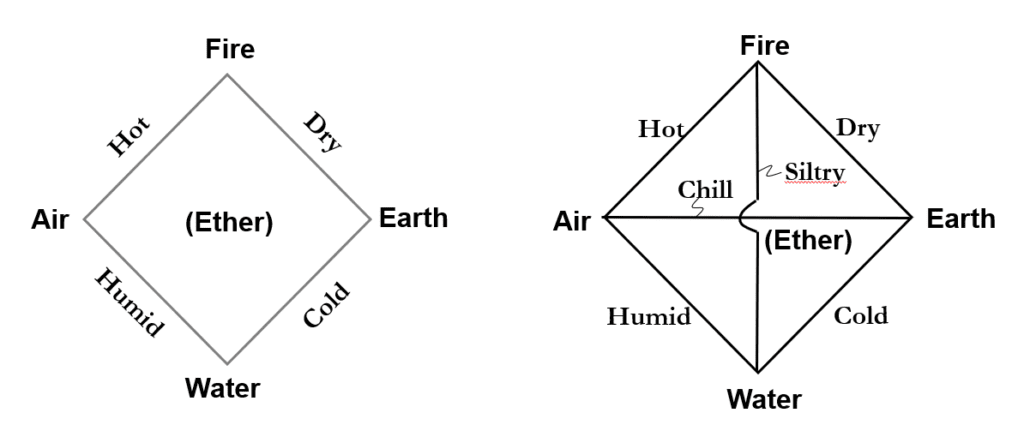The process of the flattening of tetrahedron unveils the profound complexities hidden within this foundational shape. As a geometric figure that transcends its three-dimensional form, the tetrahedron is steeped in the fundamental principles of spatial understanding, marked by its 4 vertices and 6 edges (or lines). Its apparent simplicity belies a deeper truth; the shape is not merely a collection of lines and angles, but a complex structure where form and concept are intimately intertwined. This transformation exemplifies simplification through flattening, a method that distills the essence of a tetrahedron into a two-dimensional space without losing its inherent complexity. It’s a visual and conceptual paradox that, while we reduce dimensions for ease of understanding, we simultaneously grapple with the tetrahedron’s full significance, striving to maintain system coherence within the confines of a flattened representation. This will play key roles in “The Reimagined I Ching” applying the contents or method of “I Ching tetrahedron.”
Understanding the Tetrahedron
The journey into the geometry of the tetrahedron invites us into a sculptor’s world, where dimensions are molded and shaped with an intuitive understanding of depth. However, for those of us more accustomed to the flat canvas of paper, the tetrahedron can be a challenging frontier. It’s akin to the ease with which children grasp the flat, imaginative world of cartoons over the multifaceted layers present in photographs.
Simplification Through Flattening of tetrahedron
In the world of complex concepts and high dimensions, we often find solace in simplification. The process of reducing three spatial dimensions to two, while preserving time as the remaining axis, is a common practice. This art of simplification is a recurring theme in the shift from the depth of 3D to the accessibility of 2D, a transformation observed in everything from the depiction of celestial spheres as circles to the detailed projection of geometric shapes onto a plane.
Visualizing Complexity in Two Dimensions
The need to conceptualize the tetrahedron on a two-dimensional plane has led to innovative projection techniques. We often split the representation of three-dimensional objects into multiple views—top, side, and elevation—to convey the totality of a 3D effect. These projections, incorporating bird’s-eye and perspective views, allow us to imagine depth even on a flat surface, translating the tetrahedron’s complexity into understandable visuals.

Left Figure shows a regular tetrahedron.
Right Figure shows flattening of tetrahedron, where two triangles located with two opposite sides parallel together and a dotted line to the two distant vertices of symmetry.
System Coherence of the Tetrahedron
The following two figures provide a cosmological representation of the tetrahedron, linking the four classical elements—earth, water, fire, and air—with the mystical fifth element, ether, at its center. This configuration not only connects the elements but also bridges the ancient with the modern, reflecting on Aristotle’s ether as both the debated medium for light and the contemporary understanding of the Higgs field that imparts matter with mass.

The first figure illustrates the four universal elements positioned at the tetrahedron’s four vertices. Each of the four lines represents the shared characteristic of the two vertices at either end or the midway path between them. Fire and air share heat, fire and earth share dryness, air and water share moisture, and earth and water share coldness. These shared attributes act as a bridge linking the four elements. However, as there are no connecting lines between fire and water or air and earth, a tetrahedron is not formed. This suggests that there is no relationship providing complete consistency among the four elements, indicating a lack of coherence.
This figure needs additions to become a complete system of the second figure. Dry air and cold earth share a chilly atmosphere, and the burning sun combines with the moist water to create a sultriness that ripens crops. This reflects the principle of photosynthesis, which harmonizes water and fire (light) to produce chlorophyll. The six moods typically referred to as ‘Chill’, ‘Cold’, ‘Sultry’, ‘Humid’, ‘Dry’, and ‘Hot’ deserve reevaluation in this context.
By assigning meanings to the two additional lines in the first figure, we create a tetrahedron—a system representing consistency. It becomes a stable structure in which six straight lines connect four vertices. However, in a flattened tetrahedron, the two lines intersecting vertically at the center don’t truly meet. The ether, which should occupy the tetrahedron’s spatial center, sits exactly at the plane’s center. The second is a systematic illustration that enhances the first.
Towards a Harmonious System
To transform this model into a complete, consistent system, we add meanings to the additional lines in Figure [a], thus creating a full tetrahedron. This act of completion doesn’t just provide stability but also encapsulates a symbolic synergy, as seen in processes like photosynthesis that harmoniously combine water and fire to produce life-sustaining chlorophyll.
The Flattened Tetrahedron in Systematic Illustration
Flattening the tetrahedron, as shown in Figure [b], reveals a new layer of understanding. Here, the intersecting lines at the center symbolize connections that, while not physically meeting in a two-dimensional plane, represent the elemental coherence sought after in ancient cosmology. This systematic illustration enhances our perception of the four elements and their dynamic interplay within the tetrahedron.
Embracing the Tetrahedron in Modern Thought
The study of the tetrahedron and its flattening serves as a bridge from the material to the metaphysical, from the tangible geometric shape to the intangible qualities of the universe’s components. By viewing the universe through the lens of the tetrahedron, we embrace a framework that reflects the systematic, coherent, and energy-efficient principles that govern all.
In summary, the tetrahedron is not just a shape but a fundamental template for systematic thinking, drawing a direct line from the elemental constructs of ancient cosmology to the complex dimensions of modern understanding.


Hey, you used to write fantastic, but the last few posts have been kinda boring… I miss your tremendous writings. Past several posts are just a little bit out of track! come on!
Thank you for your reading.